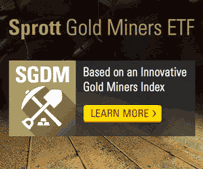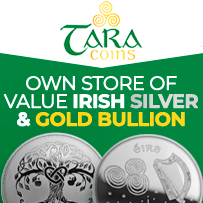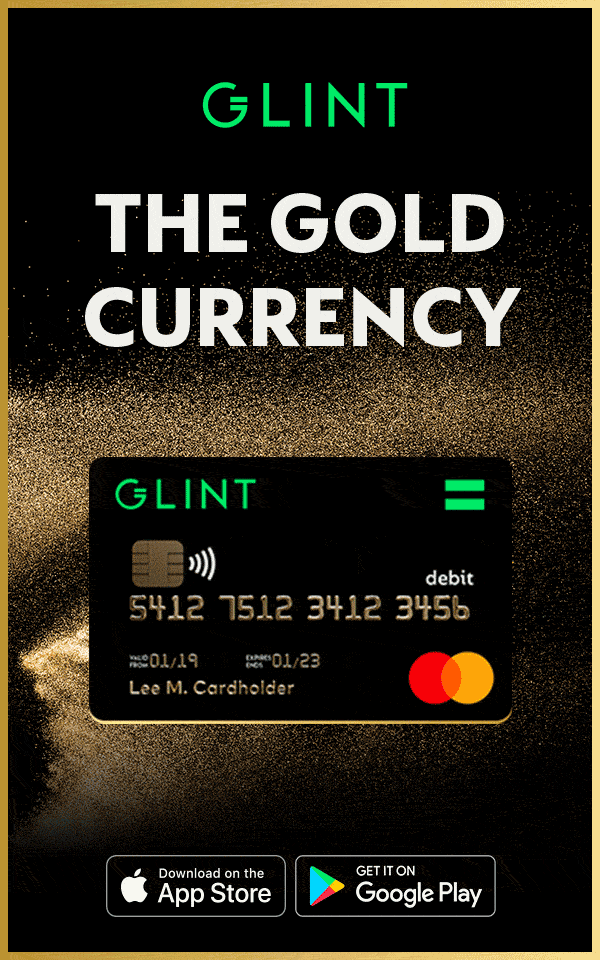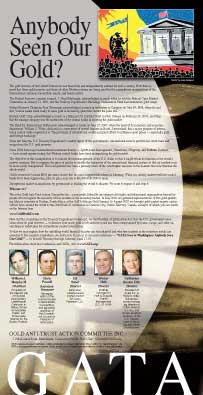You are here
Phillip Barton: The fundamental difference in gold''s favor this time
Behind 25-Year High for Gold:
Changes From Ground to Market
Technology and Strong Demand
Alter Its Odd Economics;
Inside a Secret Vault
Trading In Jewelry for Cash
By E.S. Browning
The Wall Street Journal
Wednesday, April 12, 2006
After gold soared above $500 an ounce a few months ago, tub after
plastic tub of gold jewelry from the Middle East and India began
arriving at Darren Morcombe's refinery in southern Switzerland. In a
part of the world where gold jewelry is as much an investment as an
adornment, consumers and jewelers had decided the shiny bracelets,
necklaces and belts -- many never worn -- were suddenly too valuable
to keep.
As prices skyrocket for one of the oldest forms of money, the rules
of normal economics don't apply. Fears about inflation, terrorism
and a possible dollar decline are driving gold's price up. But
production is down, because mining companies cut back capital
investment during a 1990s price slump.
Some central banks, the biggest gold investors, sold when the price
was low, and now a few are buying when the price is high. The
jewelry industry buys the bulk of each year's output, but price
today is driven more than ever by a much smaller slice of the
market -- professional investors -- whose appetite lately has
soared. After years of being squeezed, gold miners are making
fortunes, while refiners and gold bankers are getting pinched.
The price, in retreat for almost two decades after peaking at $847
in 1980, has more than doubled in the past five years, closing
yesterday in New York at $595.20 a troy ounce, near a 25-year high.
Purchases by investors jumped more than 25% by weight in 2005 alone.
Gold is the only major commodity that isn't produced primarily to be
consumed in the economy -- like iron, copper, pork bellies or
oranges -- but simply to be owned and admired. It is too heavy, soft
and rare to have many practical uses outside of electronics and
dentistry. Yet it is one of the earth's most prized objects, valued
mostly because it is considered valuable.
A look at gold's circuitous journey from the ground to refiner to
bank vault to jewelry store -- and sometimes back again -- shows how
the ancient world of gold is being shaken up by both markets and
technology.
...The Gold Chain
At the start of the gold chain stand people like Joel Lenz. He runs
two Nevada gold mines for Newmont Mining Corp., the biggest U.S.-
based gold producer. Mr. Lenz works, lives and serves on a local
school board in the mile-high desert of Nevada, where the bulk of
U.S. gold is unearthed.
As recently as the 1970s, 70% of the world's gold was taken from
South Africa's deep underground mines. South Africa remains the
world's largest producer, but its output in tons now is one-third of
what it was, and it represents 12% of the world's expanded
production. Australia and the U.S. follow with 10% each, China 9%,
Peru 8% and Russia and Indonesia 7% each, according to London-based
researcher GFMS Ltd.
The gold mined in most parts of the world, including at Mr. Lenz's
Lone Tree Mine, differs significantly from the stuff that lured
prospectors west 150 years ago. Visible sources of gold -- gleaming
mountainside veins or nuggets and powder lying in riverbeds -- are
becoming rarer. The Lone Tree Mine is an open pit two miles long and
almost 1,000 feet deep, a monstrous gash that some day will be
turned into a large lake. The gold Mr. Lenz removes from it consists
of microscopic particles laced through earth and rock.
"I've been here for 14 years," says Mark Evatz, who supervises Lone
Tree Mine's digging and transport, "and I have never seen an ounce
of gold that I have mined."
To find the gold, modern-day prospectors like Newmont's Wayne Trudel
pore over old drilling reports, set up computer models and theorize
about which mineral formations are likely to contain fine gold
particles. The process can take years, at a cost of $19 per ounce of
discovery. The geologists drill out samples from various strata and
examine them under microscopes. The results are plotted on three-
dimensional computerized maps that outline twisting underground gold
veins. As the price of gold rises, the areas on the maps considered
worth mining expand.
At Lone Tree, each ounce of gold is sprinkled through 75 tons of
rock and soil. Miners use Global Positioning System consoles to make
sure they are digging in the right spot -- since ore-rich rock looks
little different from other rock. The gold is separated from rock
and other metals through a variety of technologies that employ heat,
pressure, cyanide and charcoal.
In all, Lone Tree produces about 600 ounces of gold a day, in the
form of a damp, cake-like sludge that is 50% to 75% gold and also
includes silver and other metals.
World gold production peaked at 2,621 metric tons in 2001 -- just as
the price was falling below $260. As prices finally rose, output
actually fell. Last year, less than 2,500 tons was produced. The
reason: Opening or expanding mines can take a decade of exploring,
investing and seeking environmental approvals, and shell-shocked
companies cut such spending heavily during the long price decline.
Some were slow to invest again when prices started climbing.
Fearing further price declines, many mining companies in the 1990s
made matters worse by contracting with large banks to sell future
production in advance, at then-current prices. To pay the miners,
the banks borrowed gold from central bank reserves, sold it and
replaced it later with the mines' output. That flooded the market
with gold, depressing the price. Newmont shunned such hedging and
quickly boosted capital spending when prices rose, but the cutbacks
forced people to leave the high desert in search of work.
With Lone Tree running out of ore and its jobs now slated to
disappear, Mr. Lenz spent months in 2003 helping persuade Newmont to
reopen the nearby Phoenix Mine. It had produced gold and copper off
and on since the 1860s, and its best ore was long gone. Newmont
figures it can make money from the mine if gold sells for $340 or
more an ounce, and it agreed in late 2003 to reopen it after gold
crossed that price threshold.
... Environmental Concerns
To keep the pit from flooding, Lone Tree pumps out 45,000 gallons of
water a minute, lowering the water table in an already dry area.
Environmentalists say that mercury emitted when gold is separated
from other metals turns up in fish, wildlife and water supplies.
Nevada regulations adopted this year require gold miners to use
advanced technologies to control mercury emissions, formalizing a
voluntary program. Critics say the rules don't solve the problem.
Gold miners have been accused of more severe environmental damage in
developing countries. In February Newmont agreed to pay Indonesia
$30 million to terminate a civil lawsuit charging it with causing
disease by polluting a bay with arsenic and mercury. Newmont
officials face a separate criminal action over the same alleged
pollution, which the company denies.
When the miners at Lone Tree in Nevada are done producing gold
sludge, gun-toting guards cart it off in armored trucks. The
delivery schedule is kept secret even from senior mine executives.
The sludge is delivered to a Newmont plant in another mining town,
Carlin, about an hour away. Technicians run an electrical current
through the sludge, separating out more base metals. The gold is
formed into 100-pound "buttons" shaped like Hershey's kisses, now
finally gold-colored but tinged with red, green or black (depending
on how much copper, silver or nickel remains).
About three times a week, when 2,000 ounces to 4,000 ounces have
accumulated, workers melt the buttons into 55-pound to 60-pound
bars. The bars, between 60% and 95% gold, are known as "dor," a
French word meaning "gilded" or "golden."
The gold now heads toward the world of jewelry and high finance, via
a refinery, where the dor bars become almost pure gold. There's an
independent refinery nearby, in Utah, but Newmont sends its Nevada
dor by commercial airliner (no one will say from what airports) to
Valcambi SA, the Swiss plant where Mr. Morcombe is chairman, because
the mining company has a major stake in that refinery.
Although high gold prices make mining quite profitable, other parts
of the business have become jammed with competition and margins are
tight. Some countries maintain refineries for nationalistic reasons,
a bit like airlines, and the excess capacity is now keeping refining
charges well under a dollar an ounce. Swiss banks, which helped make
Switzerland a gold-refining center after World War II, have been
pulling back, including Valcambi's former owner Credit Suisse.
At Mr. Morcombe's refinery, in Balerna, just north of the Italian
border, the high price of gold is affecting business. Recycled
jewelry is still pouring in the door, while gold demand from
jewelers is falling since the high prices make it tough for them to
turn a profit.
Dor bars from mining operations continue to arrive. They are melted
and formed into thin rectangular plates that then can be slotted
into a bath of chemicals in a nearby room. Another electric current
is passed through, separating the gold from other metals. Depending
on its initial composition, the dor can go through that and similar
processes several times until it reaches a high level of purity --
from 99.5% to 99.99%. Before long, at a new higher-tech wing, the
refinery plans to produce gold as pure as 99.9999% (a rare level
known as six nines).
Once refined, gold heads to manufacturers, investors or retailers.
Jewelers use more than 70% of gold supplies every year. Italy long
was the leading jewelry maker. Lately, lower-cost Turkey has taken a
lot of business from Italy, and even-lower-cost India is taking some
of Turkey's business. The world's biggest jewelry retail chain is
Wal-Mart Stores Inc. But as a nation, India is the world's largest
gold-jewelry buyer.
In India and elsewhere in Asia, gold jewelry is used for dowries and
major gifts. When people have extra savings, they buy jewelry, which
can be sold either in times of need or when prices soar.
"We are selling old gold because the price is high," said Hemani
Shah, a customer recently in a Mumbai shop. "During the monsoons
when the market goes down, we'll buy."
Gold also is used in electronics because it is a fabulous conductor.
It is present in virtually all computers. Gold's use in dentistry
has been falling for years, but last year alone Americans and
Canadians had a total of 34 million teeth repaired or replaced with
fillings, caps, bridges, crowns and other dental appliances
containing gold, according to Dentsply International Inc., a dental
supply company. World-wide, dentistry eats up nearly 70 metric tons
of gold a year, says GFMS, the research group. All these business
uses account for another 15% of yearly gold supplies.
Most of the remaining gold -- 12% to 15% -- goes to private or
government investors. Much of that ends up as large rectangular bars
weighing 27 pounds or 28 pounds each, the mainstays of government
and commercial bank vaults.
When times are good, gold seems a waste of money compared with more
modern investments, such as the stocks of fast-growing companies. In
troubled times, such as during the recent bear market and following
the 2001 terrorist attacks, broader groups of investors stash part
of their nest eggs in safer places -- and gold is often seen as such
a haven. Some bearish investors, called gold bugs, tend to stick
with the metal through thick and thin.
... Wild Card
One wild card in the gold market is the world's central banks,
which, because of gold's traditional role as a store of value, long
have been the largest gold hoarders. They still own about 19% of the
world's gold, according to GFMS. European central banks, however,
have been selling gold for years. Central bank sales mounted in the
late 1990s, as gold prices fell to multiyear lows. Now, faced with
criticism that they sold too cheaply, some central bankers are
thought to be buying again, including those of Russia and some
Middle Eastern oil countries -- reflecting the temptation even among
experienced financiers to sell low and buy high.
The U.S. went off the gold standard under President Nixon, but it
still has by far the world's largest gold reserves at more than
8,000 metric tons, valued at about $153 billion. The U.S. hasn't
sold significant amounts since the Carter administration, putting
off any debate about the proper role of gold in backing a currency.
A pair of exchange-traded gold funds created in 2004 and 2005 are
helping to drive investor interest in the metal. These funds, which
are set up like mutual funds and trade on stock exchanges, allow
institutional investors and even individuals an easy way to bet on
gold. As more money flows into the funds -- which total about $7.3
billion today -- more gold must be purchased to back them.
The gold from those funds, like much of the world's investment gold,
is stored mainly in London, where nine secretive bullion banks
finance the trade. Financial institutions that own shares in the
funds occasionally ask to see the gold backing their investments,
but the two banks holding the funds' gold, HSBC Bank and Bank of
Nova Scotia, have a policy of refusing such requests. Investors must
take the word of auditors that it actually exists.
J.P. Morgan Securities in London, an arm of U.S. banking group J.P.
Morgan Chase, is another of the nine banks. It occasionally allows
visitors. Gold comes and goes from its vault with surprising
frequency, moving among miners, refiners, jewelers and investors.
It often arrives at freezing temperatures after riding in a plane's
hold. The gold is fork-lifted into a cavernous vault the size of a
basketball court, deep below the ground. Stacked on mundane wooden
pallets are billions of dollars in gleaming gold bars.
Even amid all this accumulated wealth, competition has eroded profit
margins.
On a recent morning, the phone rang at the desk of Peter Smith, who
helps run the gold business at J.P. Morgan. A bank in Dubai needed
600 bars, each 99.9% pure and weighing 10 tolas (an Indian measure).
Sitting in front of a computer with three screens, Mr. Smith phoned
a Swiss refiner and found his client some bars. The price he quoted
included a refiner's markup of 50 cents an ounce, including
shipping. The 2,250-ounce order totaled well over $1 million. The
bank's cut was five cents an ounce -- or just $112.
----------------------------------------------------
To subscribe to GATA's dispatches, send an e-mail to:
gata-subscribe@yahoogroups.com
To unsubscribe, send an e-mail to:
gata-unsubscribe@yahoogroups.com
Caution: America Online prohibits delivery of GATA
dispatches to AOL e-mailboxes.
----------------------------------------------------
RECOMMENDED INTERNET SITES
FOR DAILY MONITORING OF GOLD
AND PRECIOUS METALS
NEWS AND ANALYSIS
Free sites:
http://www.cbs.marketwatch.com
http://www.usagold.com/amk/usagoldmarketupdate.html
http://www.capitalupdates.com/
http://www.silver-investor.com
http://www.thebulliondesk.com/
http://www.goldismoney.info/index.html
http://www.minersmanual.com/minernews.html
http://www.a1-guide-to-gold-investments.com/euro-vs-dollar.html
http://www.investmentrarities.com
http://www.kereport.com
(Korelin Business Report -- audio)
http://www.plata.com.mx/plata/home.htm
(In Spanish)
http://www.plata.com.mx/plata/plata/english.htm
(In English)
http://www.resourceinvestor.com
http://www.goldpennystocks.com/
Subscription sites:
http://www.lemetropolecafe.com/
http://www.interventionalanalysis.com
http://www.investmentindicators.com/
Eagle Ranch discussion site:
http://os2eagle.net/checksum.htm
Ted Butler silver commentary archive:
http://www.investmentrarities.com/
----------------------------------------------------
COIN AND PRECIOUS METALS DEALERS
WHO HAVE SUPPORTED GATA
AND BEEN RECOMMENDED
BY OUR MEMBERS
Blanchard & Co. Inc.
909 Poydras St., Suite 1900
New Orleans, Louisiana 70112
888-413-4653
http://www.blanchardonline.com
Centennial Precious Metals
Box 460009
Denver, Colorado 80246-0009
1-800-869-5115
http://www.USAGOLD.com
Michael Kosares, Proprietor
cpm@usagold.com
Colorado Gold
222 South 5th St.
Montrose, Colorado 81401
http://www.ColoradoGold.com
Don Stott, Proprietor
1-888-786-8822
Gold@gwe.net
El Dorado Discount Gold
Box 11296
Glendale, Arizona 85316
http://www.eldoradogold.net
Harvey Gordin, President
Office: 623-434-3322
Mobile: 602-228-8203
harvey@eldoradogold.net
Gold & Silver Investments Ltd.
Mespil House
37 Adelaide Rd
Dublin 2
Ireland
+353 1 2315260/6
Fax: +353 1 2315202
http://www.goldinvestments.org
info@gold.ie
Investment Rarities Inc.
7850 Metro Parkway
Minneapolis, Minnesota 55425
http://www.gloomdoom.com
Greg Westgaard, Sales Manager
1-800-328-1860, Ext. 8889
gwestgaard@investmentrarities.com
Kitco
178 West Service Road
Champlain, N.Y. 12919
Toll Free:1-877-775-4826
Fax: 518-298-3457
and
620 Cathcart, Suite 900
Montreal, Quebec H3B 1M1
Canada
Toll-free:1-800-363-7053
Fax: 514-875-6484
http://www.kitco.com
Lee Certified Coins
P.O. Box 1045
454 Daniel Webster Highway
Merrimack, New Hampshire 03054
http://www.certifiedcoins.com
Ed Lee, Proprietor
1-800-835-6000
leecoins@aol.com
Lone Star Silver Exchange
1702 S. Highway 121
Suite 607-111
Lewisville, Texas 75067
214-632-8869
http://www.discountsilverclub.com
MRCS Canada
12303-118 Ave. NW
Edmonton, Alberta T5L 2K2
Canada
http://www.mrcscanada.com
Michael Riedel, Proprietor
1-877-TRY-MRCS
1-877-879-6727
mrcscanada@shaw.ca
Miles Franklin Ltd.
3015 Ottawa Ave. South
St. Louis Park, Minn. 55416
1-800-822-8080 / 952-929-1129
fax: 952-925-0143
http://www.milesfranklin.com
Contacts: David Schectman,
Andy Schectman, and Bob Sichel
Missouri Coin Co.
11742 Manchester Road
St. Louis, MO 63131-4614
info@mocoin.com
314-965-9797
1-800-280-9797
http://www.mocoin.com
Resource Consultants Inc.
6139 South Rural Road
Suite 103
Tempe, Arizona 85283-2929
Pat Gorman, Proprietor
1-800-494-4149, 480-820-5877
Metalguys@aol.com
http://www.buysilvernow.com
Richard Nachbar Rare Coins
5820 Main St., Suite 601
Williamsville, N.Y. 14221-8232
877-622-4227
http://www.CoinExpert.com
nachbar@coinexpert.com
Swiss America Trading Corp.
15018 North Tatum Blvd.
Phoenix, Arizona 85032
http://www.swissamerica.com
Dr. Fred I. Goldstein, Senior Broker
1-800-BUY-COIN
FiGoldstein@swissamerica.com
The Moneychanger
Box 178
Westpoint, Tennessee 38486
http://www.the-moneychanger.com
Franklin Sanders
1-888-218-9226, 931-766-6066
----------------------------------------------------
HOW TO HELP GATA
If you benefit from GATA's dispatches, please
consider making a financial contribution to
GATA. We welcome contributions as follows.
By check:
Gold Anti-Trust Action Committee Inc.
c/o Chris Powell, Secretary/Treasurer
7 Villa Louisa Road
Manchester, CT 06043-7541
USA
By credit card (MasterCard, Visa, and
Discover) over the Internet:
http://www.gata.org/creditcard.html
By GoldMoney:
http://www.GoldMoney.com
Gold Anti-Trust Action Committee Inc.
Holding number 50-08-58-L
Donors of $200 or more will receive copies
of "The ABCs of Gold Investing" by Michael
Kosares, proprietor of Centennial Precious
Metals in Denver, Colorado, and "The Coming
Collapse of the Dollar" by James Turk and
John Rubino.
GATA is a civil rights and educational
organization under the U.S. Internal Revenue
Code and contributions to it are tax-deductible
in the United States.








